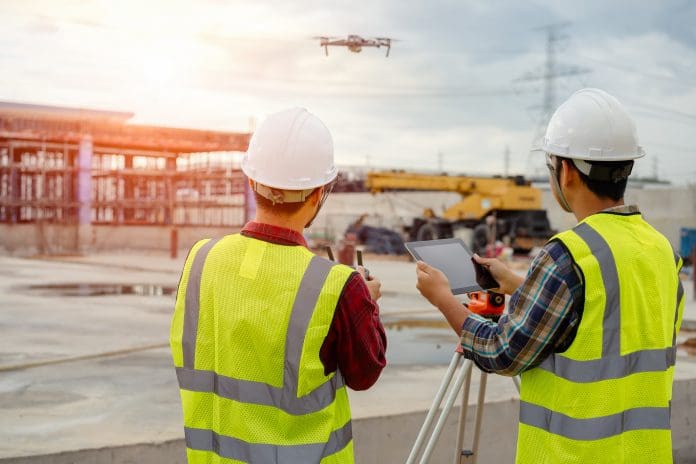Drone technology might be hitting the headlines due to their vital usage by the armed forces in global conflicts, but its potential is also fast expanding in the world of real estate. Louise Irvine, senior knowledge development lawyer at Forsters, takes a look
New developments are continuously emerging but current uses of drone technology include bird’s eye and panoramic surveys, which are particularly useful for large agricultural sites or greenfield development, carrying out inspections in hard-to-reach areas and investigating breaches of planning regulations.
Drone technology can also access areas that might be hazardous or not otherwise accessible at all, such as dilapidated buildings with structural issues (such as unstable roof spaces) or where there is known contamination. They can also provide footage for 3D surface models and imagery overlapping.
Real estate businesses are starting to ready themselves for more extensive uses of drones. Clients such as Cubex Land are incorporating drone landing pads into their new schemes, such as with the Halo Building in Bristol.
What is the current legal framework – who owns the sky?
The common legal position in England and Wales is that a landowner owns the air immediately above their land up to the height that would be reasonably necessary for the ordinary use and enjoyment of the land and the structures upon it.
This does infer a vertical limit on a landlord’s ownership and in terms of the usage of the sky above their properties.
There are also various rules that apply in different scenarios around when and where drones may be flown but as a general principle, it’s worth noting that commercial drones may not be flown within 50m of people, vehicles, vessels, buildings or other structures which the drone operator doesn’t control and must be further away still from large crowds.
At present, the regulation of drones is restrictive, particularly in busy metropolitan areas. So, the Civil Aviation Authority has not yet had to worry about managing airspace for drones. It will be a huge amount of work to ensure that drones are integrated into the existing air traffic control system, which represents a major regulatory hurdle.
Planning drone landing spots or vertiports on new build and refurbishment schemes
As business start to futureproof their buildings ready for widespread drone usage, we expect to see more landing spots or vertiports on new build and refurbishment schemes.
Roofspace on commercial buildings, such as office blocks and car parks, are largely underutilised, presenting a commercial opportunity for landlords to add value.
Landlords and developers will need to consider planning permission, firstly in relation to the use of the property as a whole and whether use as a vertiport is either permitted under the existing permitted use of the building or whether it is ancillary to the existing permitted use.
Secondly, in terms of whether the installation of external infrastructure to support a vertiport on a building will constitute development for planning permission purposes.
Planners may also need to consider the ecological impact of drone flight on animals, particularly birds. This is from the obvious risk of collision but also with disturbances and stress caused by noise, lights and the presence of drones in their natural habitat.
Nuisance, privacy and GDPR considerations
It is important to bear in mind privacy, as drones have increasingly sophisticated long-range cameras and recording devices. Using drones over private areas could constitute an invasion of privacy.
GDPR must also be factored in, as those who collate and control data from drones will need to ensure that it is being managed in accordance with regulation.
Most leases will also have restrictions against doing or permitting anything on the premises which may cause nuisance, annoyance or disturbance to the landlord, any other occupiers of the building or estate, and occupiers of any premises in the neighbourhood.
If such a clause is in the lease then the drone operator will have to consider the hours during which the drones can take off and land, and any ways in which noise can be restricted.
Future uses of drone technology
Companies such as Skyports are exploring air taxi services and have been acquiring sites for this purpose. Around 50 different countries are reportedly looking into the viability of unmanned flights forming part of their transport network, driven by often congested and ageing road networks, but it’s unlikely we’ll see any unmanned drone taxi flights before the 2030s at the earliest.
In 2016, Amazon completed its first commercial delivery using a drone in the UK as part of its Amazon Air trial using a GPS-guided drone to deliver its cargo to a home in Cambridge. But progress has since been slow.
However, in Australia, Wing (which is part of the Alphabet group) has been regularly delivering cups of coffee and other groceries by drone, apparently without any safety issues thus far.
In London, the Lyons Place residential development is the first residential development to incorporate a drone port to accommodate drone deliveries to the residents of the building. Meanwhile, Royal Mail has partnered with a few UK drone companies to start transporting parcels using drones to remote rural areas.
Skyports has also been exploring medical uses. Drones delivered Coronavirus testing kits and medical supplies to the remote region of Argyll & Bute in Scotland during the pandemic.
It remains to be seen whether drone technology will rapidly rise or if progress will be slow. Either way, there will need to be more legislation and regulation to protect privacy, flight paths and areas of national security. But the potential for drone usage to expand is clear, and it is definitely an area to keep a close eye on.
Louise Irvine
Senior knowledge development lawyer
Forsters
Tel: +44 (0)20 7863 8333














